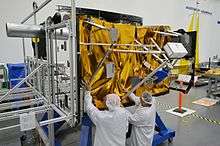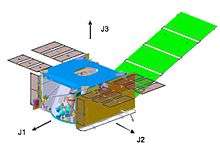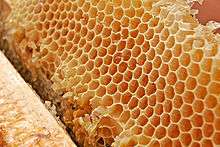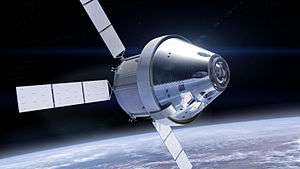Spacecraft Bus (JWST)

Spacecraft Bus is the primary support component of the James Webb Space Telescope, that hosts a multitude of computing, communication, propulsion, and structural components, bringing the different parts of the telescope together.[2] Along with the Sunshield, it forms the Spacecraft Element of the space telescope.[3] The other two major elements of the JWST are the Integrated Science Instrument Module (ISIM) and the Optical Telescope Element (OTE).[4] Region 3 of ISIM is also inside the Spacecraft Bus; region 3 includes ISIM Command and Data Handling subsystem and the MIRI cryocooler.[4]
The structure of the Spacecraft Bus must support the 6.5 ton space telescope, while it (just the structure, not the whole bus) itself weighs 350 kg (about 772 lb).[5] It is made primarily of graphite composite material.[5] It was assembled in the U.S. state of California by 2015, and then it had to be integrated with the rest of the space telescope leading up to its planned 2018 launch.[6] The bus can provide pointing of one arcsecond and isolates vibration down to two milliarcseconds[7] (arcseconds are a unit of angle equal to 1/3600 of a degree, see Minute of arc).[8] The fine pointing is done by the JWST fine guidance mirror, not by physically moving the whole mirror or bus.[8]
The spacecraft bus is on the sun-facing "warm" side and operates at a temperature of about 300 kelvins (80 °F, 27 °C).[9] Everything on the sun-facing side must be able to handle the thermal conditions of JWST's halo orbit, which has one side of continuous sunlight and the other shaded by the spacecraft sunshield.[5]
Another important aspect of the Spacecraft Bus is the central computing, memory storage, and communications equipment.[10] The processor and software direct data to and from the instruments, to the solid-state memory core, and to the radio system which can send data back to Earth and receive commands.[10] The computer also controls the pointing and moment of the spacecraft, taking in sensor data from the gyroscopes and star tracker, and sending the necessary commands to the reaction wheels or thrusters.[10]
Overview

The Bus is a carbon fibre box that houses a large number of major systems that keep the telescope functioning, such as the solar panels and computers. It also physically houses the Miri cooler and some major ISIM electronics.
There are six major subsystems in the Spacecraft Bus.[12] Major subsystems:[2]
- Electrical Power Subsystem
- Attitude Control Subsystem
- Communication Subsystem
- Command and Data Handling Subsystem (C&DH)[2]
- Command Telemetry Processor
- Solid State Recorder (SSR)
- Propulsion Subsystem
- Thermal Control Subsystem
The spacecraft bus has two star trackers, six reaction wheels, and the propulsion systems (fuel tank and thrusters).[13] Two major tasks are pointing the telescope and performing station keeping for its meta-stable L2 halo orbit.[14]
- Computing and communications
The computing systems include a solid-state data memory storage with a capacity of 58.9 GB.[13] The memory storage is called the Solid State Recorder (SSR) and is part of the Command and Data Handling Subsystem.[2] The SSR had a software test program devised to test using a software simulation of the telescope.[15]
The communications dish which can point at Earth is attached to the bus.[16] There is Ka-band and S-band radio communication.[13] The Common Command and Telemetry System is based on Raytheon ECLIPSE system.[13] The telescope is designed to communicate with NASA's Deep Space Communication Network.[16] The main Science and Operations Center is the Space Telescope Science Institute (STScI) which is in the U.S. state of Maryland.[17]
- Rocket engines, attitude control, etc.
As of 2012 the propulsion system uses 16 MRE-1 thrusters which can provide one pound of thrust each.[5] They are mono-propellent thrusters designed survive the unique thermal conditions JWST including extended periods of direct sunlight and light reflected from the sunshield.[5] There is another set of thrusts called the Secondary Combustion Augmentation Thrusters; there are four of these thrusters and they have eight pounds of thrust each.[5] Whereas the smaller thrusters are intended for aiding in precision pointing, the bigger thrusters are planned to be used for station keeping to maintain the telescope's halo orbit.[5] The MRE-1 use hydrazine as a monoproellant and the larger SCAT thrusters are bi-propllant.[18] The SCAT also uses hydrazine (N2H4), but also uses dinitrogen tetroxide (N2O4) as an oxidizer as the two fuels for its two-propellant design.[11][18][19]
- SCAT (Secondary Combustion Augmented Thrusters)
- 4 Bi-propellant rocket engines (two primary, two backup)[11]
- Runs on hydrazine (N2H4) and nitrogen tetroxide(N2O4) rocket fuel
- Dual Thruster Modules (DTMs); MRE-1 Monopropellant Rocket Engines
- There are eight(8) DTM, each with two engines for a total of 16 engines. (each DTM has two engines)
- This thruster is a mono-propellant design[11]
There is also a tank with helium gas for use as a pressurant.[11]
Overall the SCAT thrusters are used for bigger moments and the DTMs for smaller ones.[11] The SCAT engines have a specific impulse of 295 seconds.[21]
Like the rest of Webb, including the exposed Beryllium mirrors, it is designed to endure the expected level of micro-meteoroid impacts.[22]
JWST also has six reaction wheels for attitude control, which are spinning wheels that allow the orientation to be changed without necessarily using propellant to change momentum.[23][24] The reaction wheels can only provide a certain amount of change in angular momentum.[23] There is set of small thrusters that can be used in conjunction with reaction wheels, which are also limited, but by the amount of propellant on board.[5] To detect changes in direction JWST uses Hemispherical resonator gyroscope (HRG).[25] HRG are expected to be more reliable than the gas-bearing gyroscopes that were a reliability issue on Hubble Space Telescope (HST), but they cannot point as finely which is overcome by the JWST fine guidance mirror.[25] The problem with HST gyroscopes was eventually tracked down; engineers determined that the gyro failures were caused by corrosion of electric wires powering the motor that was initiated by oxygen-pressurized air used to deliver the thick suspending fluid.[26] HST got all-new gyros in 2009, assembled using pressurized nitrogen,[26] and they are expected to be more reliable.[27]
- Thermal
Thermal systems on the bus include the Deployable Radiator Shade Assemblies.[11] There are two, called DRSA-V and DRSA-H, for vertical and horizontal respectively (with respect to the coordinate system of the spacecraft bus).[11] The membrane that makes of the DRSA is a coated Kapton membrane.[11] Other thermal elements on the outside include a small radiator for the battery. There is also a narrow lower-fixed radiator shade, also made of coated Kapton membrane.[11] The coating of the membrane is silicon and VPA.[11] Other areas of the outside are covered with JWST multi-layer insulation (MLI).[11]
Electrical Power Subsystem (EPS)
The Electrical Power Subsystem provides electricity to the JWST spacecraft.[28] It consists of a set of solar panels and rechargeable batteries.,[28][29] a solar array regulator (SAR), a power control unit (PCU), and a telemetry acquisition unit (TAU).
The solar panels convert sunlight directly into electricity.[28] This raw power is fed to the SAR which consists of four redundant buck converters each operating with a maximum power point tracking (MPPT) algorithm. While the output voltage is not strictly regulated, the buck converters will not allow the spacecraft main bus voltage to drop below about 22 volts, or rise above about 35 volts. With every science instrument and all support circuits "on" simultaneously, approximately three of the four redundant converters could handle all of the power required. Typically one or two converters need be operating at a time with the other two on active standby.
The PCU (Power Control Unit) consists mainly of electronic switches that turn each science instrument or support device on or off under control of the central computer. Each switch allows power to flow to its selected instrument from the SAR. Communications with the central computer is via a 1553 bus. In addition to the power switches, processors for the SAR MPPT algorithm are located in the PCU, along with some telemetry processors, processors to detect when the spacecraft has disconnected from the launch upper stage, and some cryo-cooler controllers.
The TAU (Telemetry Acquisition Unit) consists of electronic switches for various heaters for the "hot" sides of the telescope. In addition, there are switches for the deployment actuators, and the bulk of the telemetry processors (e.g. measuring temperatures, electric power, fuel levels, etc.). The TAU communicates with the central computer via 1553 bus.
Both the PCU and TAU contain completely redundant systems with one active while the other is in standby mode or off, completely.

The rechargeable batteries of JWST are the lithium-ion type.[29] The batteries use the Sony 18650 hard carbon cell technology.[29] The batteries are designed to endure spaceflight, and should sustain 18 thousand charge-discharge cycles.[29] The solar panel is in what's called a "tail-dragger" configuration and includes five segments.[11] Each solar panel structure support is honey-comb carbon fiber composite.[11]
Some early configurations of the Bus had two solar panel wings, one on each side.[30] Part of the JWST program design was to allow different design variations to "compete" with each other.[30]
Structure
Although the Bus will operate in the weightless environment of outer space, during launch it must survive the equivalent of 45 tons.[6] The structure can support 64 times its own weight.[31]
The spacecraft structure provides state of the art capabilities to support the James Webb Space Telescope's first light mission.
— A Webb Telescope spacecraft manager as quoted by Composites World[31]
The Spacecraft Bus is connected to the Optical Telescope Element via the Deployable Tower Assembly, which also connects to the sunshield.[32] On the other side the Bus connects to the launch vehicle with a strong cone.[33] This is where the observatory attaches to the launch vehicle, and why it must support the weight, plus forces from acceleration during launch. Afterwards it must cleanly separate from the launch stage. The rest of the telescope must be strongly attached to the bus, as it points and thrusts the telescope to its correct location, orbit, and orientation.
The structure of the bus walls are made of carbon fiber composite and graphite composite.[5][34]
The bus is 3508 mm (3.5 meters 11.5 feet) long without the solar arrays.[35] From one edge of an extended radiator shade to another it is 6775 mm wide (6.7 m 22.23 feet); this includes the length of the two two-meter-wide radiator shades.[35] The tail-dragger solar array is 5900 mm long (5.9m 19.36 feet) but it is normally at an angle of 20 degrees towards the sunshield.[35] The array is in front of the sunshield segments shield deployment boom, which at the end of it also has a trim tab attached.
The bus structure itself weighs 350 kg (about 772 lb).[5]
Once JWST is launched, it begins to unfolded and extend to its operating configuration.[36] The plan is that during its first week another part of JWST (the deployable tower) will extend, which will separate the bus from the upper spacecraft by about 2 meters.[36]
Testing: JWST IV & V Simulation and Test (JIST) Solid State Recorder (SSR) Simulator
A software simulation of the Solid-State Recorder was developed for testing purposes, which supports the overall software simulation of JWST.[15] This is called the JIST SSR simulator, and was used to test flight software with SpaceWire and MIL-STD-1553 communication, as it relates to the SSR.[15] An Excalibur 1002 Single Board Computer ran the test software.[15] The SSR test software an extension of the JIST software which is called JWST Integrated Simulation and Test core (JIST).[15] JIST brings together software simulations of JWST hardware with actual JWST software, to allow virtual testing.[15]
The simulated SSR was created to support making a software test version of the JWST, to help validate and test the flight software for the telescope.[15] In other words, rather than using an actual test hardware version of the SSR, there is a software program that simulates how the SSR works, which runs on another piece of hardware.[15]
The SSR is part of the Command and Data Handling Subsystem.[2]
Construction
.jpg)
The spacecraft element is made by Northrop Grumman Aerospace Systems.[32] The sunshield and Bus are planned to be integrated in 2017.[37]
In 2014 Northrop Grumman began construction of several spacecraft bus components including the gyroscopes, fuel tanks, and solar panels.[38] On May 25, 2016, the spacecraft's panel integration was completed.[38] The overall spacecraft bus structure was completed by October 2015.[6] The spacecraft bus was assembled at facilities in Redondo Beach, California in the United States.[6] The completed spacecraft bus was powered on for first time in early 2016.[39]
The solar arrays completed a preliminary design audit in 2012, moving to the detailed design phase.[40] Fuel and oxidizer tanks were shipped out to assembly in September 2015.[41]
In 2015 the communications subsystems, star trackers, reaction wheels, fine sun sensors, deployment electronics Unit, command telemetry processors, and wire harnesses were delivered for construction.[42]
From 2016 to 2018, there are installations and tests for the telescope and the telescope plus the instruments, followed by shipping to NASA's Johnson Space Center in Houston, Texas where end-to-end optical testing in a simulated cryo-temperature and vacuum space environment will occur... Then all the parts will be shipped to Northrop Grumman for final assembly and testing, then to French Guiana for launch.
— Paul Geithner, Webb telescope manager - Technical, at NASA Goddard[43]
The spacecraft bus will be assembled with the Spacecraft Element and the other parts in California.[44]
For launch, the spacecraft bus is attached to the Ariane 5 on a Cone 3936 plus ACU 2624 lower cylinder and clamp-band.[33] It is a contained launch fairing 4.57 meters (15 ft) and 16.19 meters (53.1 ft) of usable interior length.[33]
Gyroscopes
JWST uses a type of gyroscope known as a hemispherical resonator gyroscope (HRG).[25] This design has no bearings, rubbing parts,[45] or flexible connections.[25] This is not a traditional mechanical gyroscope; instead, an HRG has a quartz hemisphere vibrating that vibrates at its resonant frequency in a vacuum.[25] Electrodes detect changes if the spacecraft moves to collect the desired information, and the design is predicted to have a mean time before failure of 10 million hours.[25] Gyroscopes failed on several occasions on the Hubble Space Telescope and had to be replaced several times. However, these were a different design called a gas-bearing gyroscope, which have certain benefits, but experienced some long-term reliability issues.[46] JWST will have six gyroscopes, but only two are required for pointing.[45] JWST does not need as precise pointing because it has a Fine Steering Mirror that helps counter small motions of the telescope.[45]
The JWST telescope still has spinning reaction wheels, which can be adjusted to point the telescope without using propellant.[23] The gyroscopes are sensors that provide information, while the reaction wheels are devices that physically change the orientation of the spacecraft.[23] JWST has both reaction wheels and gyroscopes, which work together with the other systems to keep the telescope in the right orbit and pointed in the desired direction.[23]
There are two main traditional uses for gyroscopes in a spacecraft: to detect changes in orientation, and to actually change the orientation. JWST uses HRG as sensors to detect changes in orientation as opposed to actual spinning gyroscopes. However, it also has a set of actual spinning reaction wheels to turn the telescope without using propellant. It also has a set of small thrusters that can physically change the attitude of the telescope.
Docking ring

In 2007, NASA said that JWST will also have a docking ring which would be attached to the telescope to support JWST being visited by an Orion spacecraft if such a mission became viable.[47] An example of a mission was if everything worked but an antenna did not fold out.[47]
Integration
The Spacecraft Bus is integrated into the whole JWST during construction.[48] The Spacecraft Bus and the Sunshield segment are combined into what's called the Spacecraft Element, which is in turn combined with a combined structure of the Optical Telescope Element and Integrated Science Instrument Module called OTIS.[48] That is the whole observatory, which is mounted to a cone which connects the JWST to the last stage of the Ariane 5 rocket.[48] The Spacecraft Bus is where that cone connects to the rest of JWST.
See also
References
- ↑
- 1 2 3 4 5 NASA - Spacecraft Bus
- ↑ "Observatory - JWST/NASA". jwst.nasa.gov. Retrieved 2017-01-20.
- 1 2 "The James Webb Space Telescope". jwst.nasa.gov. Retrieved 2017-01-24.
- 1 2 3 4 5 6 7 8 9 10
- 1 2 3 4 "James Webb Space Telescope passes another milestone - SpaceFlight Insider". www.spaceflightinsider.com. Retrieved 2017-01-20.
- ↑ Sloan, Jeff. "James Webb Space Telescope spacecraft inches towards full assembly : CompositesWorld". www.compositesworld.com. Retrieved 2017-01-20.
- 1 2 "FAQ-Public JWST/NASA". jwst.nasa.gov. Retrieved 2017-01-24.
- ↑ Ross, Ronald G. (2007-02-15). Cryocoolers 13. Springer Science & Business Media. ISBN 9780387275338.
- 1 2 3 "The James Webb Space Telescope". jwst.nasa.gov. Retrieved 2017-01-20.
- 1 2 3 4 5 6 7 8 9 10 11 12 13 14 15 Status of the JWST Sunshield and Spacecraft
- ↑ "James Webb Space Telescope passes another milestone - SpaceFlight Insider". www.spaceflightinsider.com. Retrieved 2017-09-16.
- 1 2 3 4 EoPortal - JWST
- ↑ "JWST - eoPortal Directory - Satellite Missions". directory.eoportal.org. Retrieved 2017-11-03.
- 1 2 3 4 5 6 7 8 Group, Techbriefs Media. "JWST IV&V Simulation and Test (JIST) Solid State Recorder (SSR) Simulator - Nasa Tech Briefs :: NASA Tech Briefs". www.techbriefs.com. Retrieved 2017-01-20.
- 1 2
- ↑ "FAQ-Public JWST/NASA". jwst.nasa.gov. Retrieved 2017-11-03.
- 1 2 "What kind of thrusters will the James Webb Space Telescope use for station keeping?". space.stackexchange.com. Retrieved 2017-01-20.
- ↑
- ↑ James Webb Space Telescope Initial Mid Course Correction Monte Carlo Implementation using Task Parallelism
- ↑
- ↑
- 1 2 3 4 5
- ↑
- 1 2 3 4 5 6 JWST FAQ
- 1 2 "Gyroscopes". ESA. Retrieved June 9, 2012.
- ↑ Harwood, William (October 30, 2008). "Endeavour to go Nov. 14; Hubble slips deeper into '09". Spaceflight Now. Retrieved January 6, 2009.
- 1 2 3
- 1 2 3 4 "ABSL Space Products Awarded James Webb Space Telescope Satellite Lithium-Ion Battery Contract". www.abslspaceproducts.com. Retrieved 2017-01-20.
- 1 2
- 1 2 James Webb Space Telescope spacecraft inches towards full assembly 2015
- 1 2 Neil English - Space Telescopes: Capturing the Rays of the Electromagnetic Spectrum - Page 290 (Google Books
- 1 2 3 "The Launch - JWST/NASA". jwst.nasa.gov. Retrieved 2017-01-20.
- ↑ "Northrop Grumman Corporation - Investor Relations - News Release". investor.northropgrumman.com. Retrieved 2017-01-20.
- 1 2 3
- 1 2
- ↑ Astrophycis Update 2015 - Paul Hertz
- 1 2 "James Webb Telescope -". hubblesite.org. Retrieved 2017-01-20.
- ↑ Corporation, Northrop Grumman. "NASA's James Webb Space Telescope Reaches Major Milestone in Path to Launch with the Completion and Delivery of Optical Telescope Element". GlobeNewswire News Room. Retrieved 2017-01-20.
- ↑ "Fabrication of Northrop Grumman-Built Spacecraft for NASA's James Webb Space Telescope Moves Forward With Design Completion of Key Communications Structure". Northrop Grumman Newsroom. Retrieved 2017-01-20.
- ↑ "News Room". www.orbitalatk.com. Retrieved 2017-01-20.
- ↑
- ↑
- ↑ Jenner, Lynn (2016-02-24). "NASA's James Webb Space Telescope Coming Together Over Next Two Years". NASA. Retrieved 2017-01-20.
- 1 2 3 "FAQ-Public JWST/NASA". jwst.nasa.gov. Retrieved 2017-01-20.
- ↑
- 1 2 "NASA Adds Docking Capability For Next Space Observatory". Space.com. Retrieved 2017-01-28.
- 1 2 3
